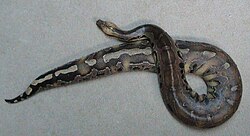| Sumatran short-tailed python | |
|---|---|
 | |
| Scientific classification | |
| Kingdom: | Animalia |
| Phylum: | Chordata |
| Class: | Reptilia |
| Order: | Squamata |
| Suborder: | Serpentes |
| Family: | Pythonidae |
| Genus: | Python |
| Species: | P. curtus |
| Binomial name | |
| Python curtus Schlegel, 1872 | |
| Synonyms | |
Aspidoboa curta Sauvage, 1884 | |
The Sumatran short-tailed python [1] (Python curtus), also called the Sumatra python, [2] is a species of the family Pythonidae, a nonvenomous snake native to Sumatra. [1]


